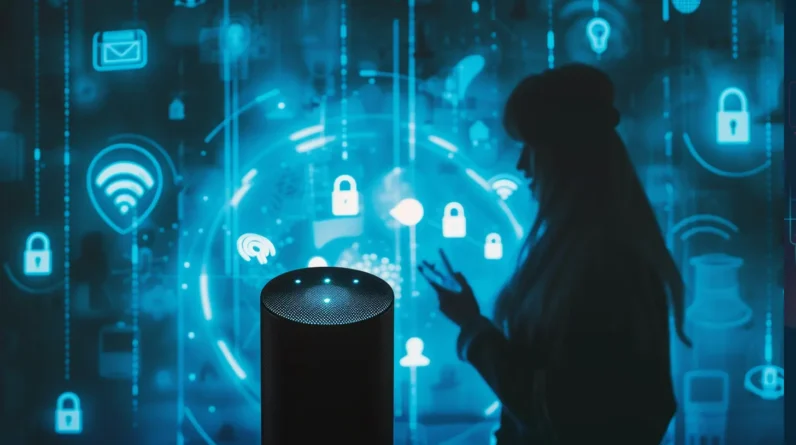
When it comes to the widespread presence of popular smart speakers in our daily lives, there are certain ‘unseen considerations’ that warrant closer attention. The allure of convenience these devices offer can sometimes overshadow the potential vulnerabilities they bring into our homes and workplaces. Data breaches and eavesdropping concerns are just a few of the multifaceted security risks associated with smart speakers that often go unnoticed. As we navigate this technological landscape, it’s crucial to explore the implications of our reliance on these devices and how they may impact our privacy and security.
Data Breaches
Data breaches pose a significant threat to the security of smart speakers, potentially exposing sensitive personal information to malicious actors. These breaches can occur through various means, such as unauthorized access to the device’s data storage or interception of data during transmission.
Once a breach happens, the compromised data can be used for identity theft, fraud, or other malicious activities. To mitigate these risks, it’s crucial to regularly update the smart speaker’s software and firmware to patch any known vulnerabilities. Users should also set strong, unique passwords for their devices and enable two-factor authentication whenever possible.
Staying vigilant and informed about potential security threats is essential in safeguarding personal data from falling into the wrong hands. Based on our analysis, we believe that taking these precautions is necessary to protect the privacy and security of smart speaker users.
Privacy Vulnerabilities
Privacy vulnerabilities in smart speakers can expose users to potential risks of unauthorized access to their personal information. These vulnerabilities may stem from inadequate encryption protocols, weak authentication methods, or even unpatched software bugs. Hackers could exploit these weaknesses to intercept sensitive data such as passwords, financial information, or even audio recordings.
To mitigate these risks, users should regularly update their devices, use strong, unique passwords, and be cautious about the type of information shared with smart speakers. Understanding and addressing these privacy vulnerabilities is essential in safeguarding personal data and maintaining a secure smart speaker environment.
Based on our analysis, we believe it’s crucial for manufacturers to prioritize security measures when designing smart speakers. This includes incorporating robust encryption protocols, implementing strong authentication mechanisms, and promptly addressing any software vulnerabilities through regular updates.
In our view, user awareness and education are also key in mitigating privacy risks. Users should be informed about the potential risks associated with smart speakers and provided with guidelines on how to protect their privacy. This can include recommendations on disabling certain features, managing permissions, and being cautious about the types of data shared with the device.
From our perspective, the integration of privacy-focused features, such as physical mute buttons and indicators that clearly show when the device is actively listening or transmitting data, can also enhance user control and transparency.
Eavesdropping Concerns
Analyzing the potential risks associated with eavesdropping on smart speakers reveals critical vulnerabilities that can compromise user security.
Smart speakers, like many IoT devices, constantly listen for wake words to activate. This always-on listening feature poses a significant privacy risk, as these devices may inadvertently record sensitive information.
While tech companies claim that these recordings are only stored and analyzed after triggering the wake word, there have been instances of accidental activations. Hackers could potentially exploit these vulnerabilities to eavesdrop on private conversations or gather personal data.
To mitigate these eavesdropping concerns, users should regularly review their smart speaker settings, disable unnecessary features, and consider the placement of these devices in their homes to minimize the risk of unauthorized listening.
We believe that taking these precautions is essential in safeguarding user privacy and ensuring the security of personal information.
Malware Threats
Upon connecting to unsecured networks, smart speakers can inadvertently download malicious software, posing significant malware threats to user security.
Malware Threats:
1. Botnets: Smart speakers can become part of botnets, used to carry out large-scale cyber attacks.
2. Spyware: Malicious software can spy on users, recording sensitive information without their knowledge.
3. Ransomware: Smart speakers are vulnerable to ransomware attacks, where hackers can lock users out until a ransom is paid.
These malware threats highlight the importance of securing smart speakers and being cautious when connecting them to networks to prevent potential security breaches. We believe it’s crucial for users to take necessary precautions to protect their privacy and data.
Based on our analysis, incorporating strong passwords, regularly updating firmware, and only connecting to secure networks can significantly mitigate the risk of malware attacks. Additionally, it’s essential to install reputable security software on all devices connected to smart speakers to detect and remove any potential threats.
Third-Party Access
Connecting smart speakers to third-party services and devices can introduce potential security risks, particularly in terms of third-party access to user data and systems. When users link their smart speakers to external services or devices, they’re granting those third parties access to various aspects of their personal information. This access can lead to privacy breaches, data leaks, and even unauthorized control of smart home systems.
Third-party access vulnerabilities can arise from inadequate security measures implemented by these external services or devices. Users must carefully review the permissions they grant when connecting their smart speakers to third-party platforms and regularly monitor and manage these connections to mitigate potential security threats.
Based on our analysis, it’s important to be cautious when incorporating third-party services and devices with smart speakers. We believe that users should be aware of the potential risks that come with granting access to their personal information. In our view, it’s crucial to regularly assess the security measures implemented by these external services or devices and take necessary actions to protect user data and systems.
Device Hijacking
Device hijacking poses a significant threat to the security of smart speakers, potentially leading to unauthorized access and control over the device and connected systems. When a smart speaker falls victim to hijacking, the consequences can be severe. Here are three key risks associated with device hijacking:
1. Unauthorized Access: Hijackers can gain access to personal data stored on the smart speaker, compromising privacy. We believe that understanding these risks is crucial for maintaining the security of smart speaker systems.
2. Malicious Control: Hijackers may take control of the smart speaker to eavesdrop on conversations or even issue commands to connected devices. Based on our analysis, this can lead to serious privacy breaches and potential misuse of personal information.
3. Data Theft: Hijacked smart speakers can be used to steal sensitive information like passwords or financial details, putting users at risk of identity theft. In our view, this highlights the importance of implementing strong security measures to protect against device hijacking.
It is important for users and manufacturers to be aware of these risks and take necessary precautions to prevent device hijacking. By incorporating robust security protocols and regularly updating software, we can ensure the safety and privacy of smart speaker systems.
Regulatory Compliance
Ensuring the security of smart speaker systems requires meticulous attention to regulatory standards. Compliance with regulations like the General Data Protection Regulation (GDPR) and the California Consumer Privacy Act (CCPA) is crucial for safeguarding user privacy and data. These regulations impose strict requirements on the collection, storage, and processing of personal information by smart speakers.
Non-compliance not only carries legal risks but also undermines user trust in the device. Moreover, regulatory compliance ensures that manufacturers implement robust security measures, conduct regular security audits, and provide transparent privacy policies. By meeting these standards, smart speaker companies demonstrate their commitment to data protection and establish a foundation of trust with consumers.
We believe that regulatory compliance is an integral part of smart speaker systems, providing reassurance to users and promoting responsible data handling practices.
Conclusion
While popular smart speakers offer convenience and connectivity, they also come with hidden security risks. These risks include data breaches, privacy vulnerabilities, eavesdropping concerns, malware threats, and third-party access to device hijacking.
We’re certain that by following these precautions, users can enjoy the convenience of smart speakers while minimizing the potential security risks.







